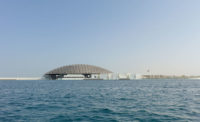To update Switch Abu Dhabi in Al Bateen—one of the more exclusive areas packed with upscale shops—interior designer Karim Rashid thought he could attract more attention with curves than color. Rashid, an Egyptian-born designer known for his eye-popping futuristic designs for luxury brands Christofle, Veuve Clicquot, and Alessi, and restaurants Kurve and Morimoto, has a reputation for coaxing upmarket looks from a carefully edited list of monochrome building materials. And on the heels of its first Switch Restaurant and Lounge, owners the Independent Food Company wanted their second spot to bring the area a distinctly non-traditional experience.
To deliver a one-of-a-kind design, Rashid decided to break up its boxy, one-story volume, which viewed from the outside blends in with neighboring buildings the same height.
Keeping the interior walls and ceilings white not only saved on construction costs, but also helped reflect daylight deeper into the corner space and allowed Rashid’s new curves to be the focus of the 2,475-square-foot main dining room, according to Steven Robinson, senior project manager of Compass Project Management, which helped execute the renovation.
To achieve the seamless appearance of the egg-like interior, Rashid used GRP (Glass Reinforced Polyester) and GRC (Glass Reinforced Concrete) to cast custom moldings onsite, which the team adhered to bare straight planes of the ceiling and walls. He says he chose the materials because they’re lightweight, durable, and easy to shape. Curves echo in the furniture, which he also designed, especially the Hoop chair from B-Line srl, with its scooped seat of gray polyurethane. The dining tables by Cizeta comprised of white Corian tops and stainless steel bases are also Rashid’s custom design.
Because the restaurant has only two exterior walls facing a busy retail strip, Rashid needed artificial lighting solutions as well as windows. His team specified concealed white-tunable RGB cove lighting by Skylume behind the banquettes and LED downlights by Flos throughout, giving the space its mysterious moonscape glow. “Scooping out walls created niches ideal for different seating zones,” says Rashid. A scooped-out window in one wall provides outside passersby with a voyeuristic glimpse into the bar’s egg-shaped service window, and adds much needed daylight, he says. His big daylighting idea was to orient the dining room toward a wall where he installed two large sliding windows. When they are ajar, the dining room joins its adjacent outdoor café, open to the lively pedestrian walkway.
The connection to the outdoors is intentional. Rashid says, “Visitors aren’t just experiencing spaces visually, but sensorially immersing themselves. Hopefully, I’m transcending their notions of public space and inspiring them to live more progressively.”
And how to update the squat square façade without altering its load-bearing walls? Rashid designed a 796-square-foot screen of aluminum and white acrylic sheets to cover it; these sandwiched LEDs, illuminating a pattern of perforated Arabic characters, spell out poetry. The writing on the wall is a continuation of a branded design detail in the original Switch.
“Good design speaks simply and directly,” Rashid says of his choices, “without being superfluous or speaking to the past.”







